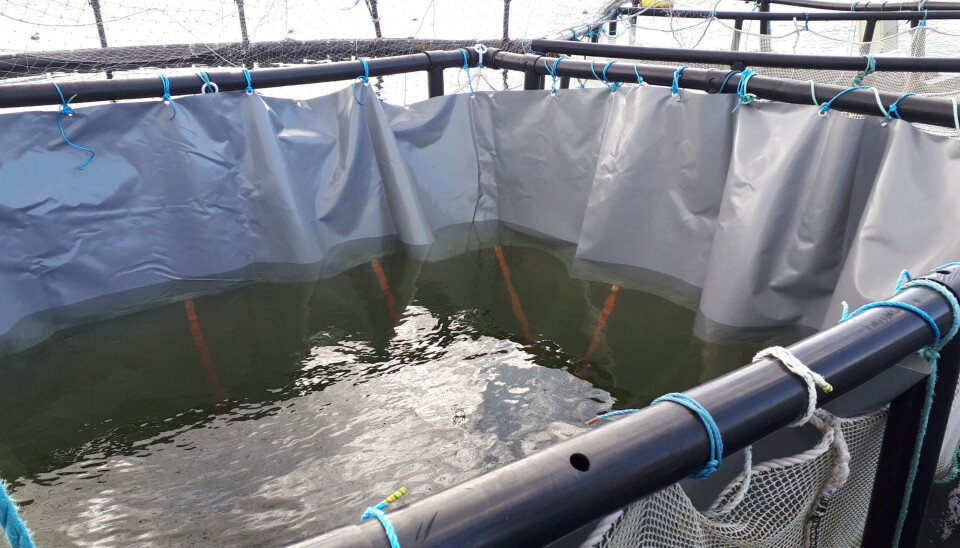
Passing the screen test
A trial in Ireland has demonstrated that a fine-mesh bag installed inside a salmon pen can exclude lice and micro jellyfish but let water pass through.
On 6 March 2023 Salar Pursuits completed a proof-of-concept trial on its patented porous semi-closed contained salmon aquaculture system, trademark SmoltscreenTM with the Marine Institute of Ireland (MI) at its trial aquaculture site in Cashel Bay, Galway. The trial ran from 15 November 2022 to 6 March 2023 in a sentinel pen, incorporating the retro-fitted fine mesh (150-micron nylon woven) enclosure with a volume of 49 cubic metres, alongside a sentinel control pen with standard 18 mm knotless nylon netting with a volume of 64m3.
On 15 November last year, 400 organic salmon smolts were stocked into the Smoltscreen and 400 into the control pen at an average weight of 72 grams. At the fourth and final MI fish sampling on 23 February 2023 the average weight of the Smoltscreen smolts was 149g (60-290g).
At the fourth and final MI fish sampling on 23 February 2023 the average weight of the Smoltscreen smolts was 149g (60-290g) and the average for the control pen was 151g (59-310g). In the 3.5-month trial, three smolts died in the control pen and there were no mortalities in the Smoltscreen pen. At the final MI fish sampling on 23 February the total weight of stock was estimated at 59.6 kg, based on the average sampled weight of 149g/smolt, giving a stock density of 1.22 kg/m3. At the same time, the stock in the control pen was 59.8 kg with a density of 1.07 kg/m3.
The Smoltscreen was supplied with oxygenating water from a stainless-steel submersible pump suspended 10 metres beneath the feed barge. The water was filtered through a 150-micron titanium basket strainer and delivered to the Smoltscreen through a 4” (10cm) pipe. The flow rate averaged 112 litres per minute, providing circa 1.5-2 litres/minute/kg of stocked fish, maintaining dissolved oxygen (DO) of between 71-88% during the period to 6 December. The incoming flow of water into the enclosure was flowing out through the nylon mesh enclosure, and the pressure equilibrium inside and outside the enclosure was well maintained.
The Smoltscreen was cleaned weekly with a hand controlled two-disc power washer. This worked perfectly from 15 November until 6 December, when problems with blocking nozzles began to occur and the cleaning of the mesh enclosure became less thorough. It was decided to suspend a second stainless steel submersible pump into the centre of the Smoltscreen to maintain the water exchange, with DO not below 70%, until new nozzles could be shipped to Cashel to repair the cleaner. With a water exchange of between 112 and 120 litres per minute maintaining the pressure difference and the DO at between 77-89% thereafter, the flow conditions remained optimised until the cleaner could be finally repaired on 20 February, and the water flow was fully restored through the mesh.
During the period of compromised flow through the mesh, the problem of a small number of precocious males occurred and appeared in the MI fish sampling of 23 February. Dr Carolina Gutierrez of PHARMAQ Analytiq Ireland, advised what might have been responsible in this respect:
“As you mentioned, sexual maturation is a complex issue as many different factors can play part, being the most common ones - water temperature (especially, fluctuations) and photoperiod.
“So, yes, it is possible that such fluctuation (in water flow) for 3 months could have triggered early maturation. Also, if the exchange rates were low on that system, there may be potential accumulation of different metabolites that could also trigger early maturation in combination with water temperatures (and could also explain why the fish were swimming deeper in that system).”
An important learning from this incident was that the Smoltscreen operated well when it was cleaned weekly and this is the benchmark for maintaining optimum conditions for the salmon, using the latest trackless power washing net cleaners, such as the range offered by AKVA Scotland.
























































